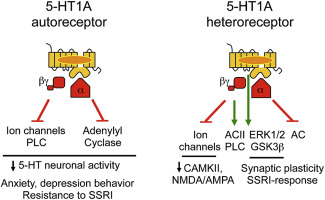Biochimie ( IF 3.9 ) Pub Date : 2018-10-25 , DOI: 10.1016/j.biochi.2018.10.015 Paul R. Albert , Faranak Vahid-Ansari

|
The 5-HT1A receptor is highly expressed both in 5-HT neurons as a presynaptic inhibitory autoreceptor, and in many brain regions innervated by 5-HT as a post-synaptic heteroreceptor. This review examines the signaling of 5-HT1A receptors to regulate 5-HT activity and behavior. Initial findings in heterologous cell systems, neuronal cell lines, neurons, and in vivo show that the 5-HT1A receptor is a Gi/o-coupled receptor that signals to the canonical pathway of inhibition of adenylyl cyclase (AC). However, new neuron-specific pathways and their roles in neuronal function have been uncovered. 5-HT1A receptor coupling via Gβγ subunits reduces neuronal activity by opening potassium channels and closing calcium channels. However, the receptor coupled primarily to Gi3 in 5-HT neurons and Gi2 in hippocampal neurons, which may underlie differential signaling and desensitization in these cells. While in 5-HT neurons, the 5-HT1A receptor appears to inhibit extracellular regulated protein kinase (ERK) ERK1/2 activity, it signals to activate it in developing and adult hippocampal neurons, and may play roles in synaptogenesis. Recent studies implicate 5-HT1A signaling through Gβγ and tyrosine kinase receptors to activate ACII, phospholipase C (PLC)/protein kinase C (PKC), calcium-calmodulin-dependent protein kinase II (CAMKII), and phosphatidyl inositol 3′-kinase (PI3K)/Akt signaling mediating synaptogenesis, cell survival, and behavioral actions of antidepressants. Thus, the 5-HT1A receptor appears to modify its signaling repertoire depending on the cell type (5-HT vs. post-synaptic neurons) and the developmental state of the neuron. Enhancement of cell specific signaling of the 5-HT1A receptor may provide an amplification of the antidepressant actions of 5-HT1A receptor activation. In addition, in response to prolonged 5-HT elevation upon chronic antidepressant treatment, the 5-HT1A autoreceptor appears to desensitize more extensively than the heteroreceptor. The mechanisms of 5-HT1A receptor desensitization are discussed, highlighting the potential of enhancing autoreceptor desensitization to accelerate antidepressant response.
中文翻译:

5-HT1A受体:行为信号
5-HT1A受体在5-HT神经元中作为突触前抑制性自体受体高表达,并在许多由5-HT神经支配的神经区域中作为突触后异质受体高表达。这篇评论检查了5-HT1A受体调节5-HT活性和行为的信号传导。在异源细胞系统,神经元细胞系,神经元和体内的初步发现表明5-HT1A受体是一个Gi / o偶联受体,可向抑制腺苷酸环化酶(AC)的规范途径发出信号。但是,已经发现了新的神经元特异性途径及其在神经元功能中的作用。通过Gβγ亚基的5-HT1A受体偶联通过打开钾通道和关闭钙通道降低神经元活动。然而,该受体主要与5-HT神经元中的Gi3和海马神经元中的Gi2偶联,这可能是这些细胞中差异信号转导和脱敏的基础。虽然在5-HT神经元中,5-HT1A受体似乎抑制细胞外调节蛋白激酶(ERK)ERK1 / 2活性,但它在发育中和成年海马神经元中信号激活它,并可能在突触形成中起作用。最近的研究表明5-HT1A信号通过Gβγ和酪氨酸激酶受体激活ACII,磷脂酶C(PLC)/蛋白激酶C(PKC),钙钙调蛋白依赖性蛋白激酶II(CAMKII)和磷脂酰肌醇3'激酶( PI3K)/ Akt信号传导介导突触形成,细胞存活和抗抑郁药的行为作用。因此,取决于细胞类型(5-HT与突触后神经元)和神经元的发育状态,5-HT1A受体似乎可以改变其信号传导范围。5-HT1A受体的细胞特异性信号传导的增强可能会增强5-HT1A受体激活的抗抑郁作用。另外,响应于慢性抗抑郁药治疗后5-HT升高的持续时间,5-HT1A自身受体似乎比异源受体更广泛地脱敏。



























 京公网安备 11010802027423号
京公网安备 11010802027423号